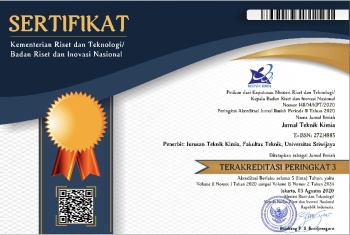Pengaruh konsentrasi asam dan waktu hidrolisis pada pembentukan bioetanol dari daun nanas
Abstract
Kebutuhan energi yang kian meningkat tidak diimbangi dengan cadangan bahan bakar fosil yang semakin menipis. Krisis energi ini menuntut adanya pengembanganenergi alternatif pengganti bahan bakar fosil. Salah satunya ialah pemanfaatan biomassa menjadi bioenergi. Daun nanas merupakan biomassa yang mengandung selulosa yang cukup tinggisehingga dapat dijadikan bahan baku alternatif pembuatan bioetanol. Penelitian ini bertujuan untukmemproduksi bioetanol dari daun nanas melalui alkaline pretreatment, kemudian dihidrolisis dengan asam sulfat, dan difermentasi oleh Saccharomyces cerevisiae. Jangkauan variabel yang digunakan ialah konsentrasi asam sulfat 1, 2, 3, 4, dan 5% dengan waktu hidrolisis 30, 60, 90, dan 120 menit. Diperoleh bioetanol tertinggi pada konsentrasi asam sulfat 2% dengan waktu 120 menit sebesar 6,244%.
References
Brethauer, S. and Wyman, C.E. 2010. Review: Continous Hydrolysis and Fermentation For Cellulosic Ethanol Production. Bioresource Technology: 4862-4874.
Daud, M., W. Safii, K. Syamsu. 2012. Biokonversi Bahan Berlignoselulosa Menjadi Bioetanol Menggunakan Aspergillus niger dan Saccharomyces cerevisiae. Jurnal Perennial. 8(2): 43-51.
Demirbas, A. 2005. Bioethanol from cellulosicmaterials: A renewable motor fuel from biomass. Energy Sour. 27: 327–337.
Hidayat, P. 2008. Pemanfaatan Serat Daun Nanas Sebagai AlternativeBahan Baku Tekstil.Teknoin.
13(2) :31-35.
Jayanudin.2009. Pemutihan Daun Nanas Menggunakan Hidrogen Peroksida.Jurnal Rekayasa Proses. 1(3): 10-14
Kristina, E.R. Sari, Novia. 2012. Alkaline Pretreatment dan Proses Simultan Sakarifikasi-Fermentasi untuk Produksi Etanol dari Tandan Kosong Kelapa Sawit. Jurnal Teknik Kimia. 18 (3) : 34-43.
Kumar, P., Barrett, D.M., Delwiche, M.J., and Stroeve, P. 2009. Methods for Pretreatment of Lignocellulosic Biomass for Efficient Hydrolysis and Biofuel Production. Industrial & Engineering Chemistry research.
Limayem, A. and Ricke, S.C. 2012. Lignocellulosic Biomass For Bioethanol Production: Current Perspectives, Potential Issues, and Future Prospects. Progress in Energy and Combustion Sciences. 38: 449-467.
Monserrate, E., S.B. Leschine, E.C. Parola. 2001. Clostridium hungatei sp.nov., a mesophilic, N2-fixing cellulolytic bacterium isolated from soil. International Journal of Systematic and Evolutionary Microbiology. 51: 123-132.
Mosier, N., C. Wyman, B. Dale, R. Elander, Y. Lee, M. Holtzapple, and M. Ladish. 2005. Features of promising technologies for pretreatment of lignocellulosic biomass. Bioresource Technology. 96: 673−686.
Onggo, H. 2007. Produk Serat Daun Nenas Berbasis Teknologi Tepat Guna. Workshop Sosialisasi dan Implementasi Produk Agroindsutri Nenas Berbasis Teknologi Tepat Guna, 6-7 Juni 2007.
Osvaldo, Z.S., Panca, P.S., Faizal, M. 2012. Pengaruh Konsentrasi Asam dan Waktu Pada Proses Hidrolisis dan Fermentasi Pembuatan Bioetanol dari Alang-alang. Jurnal Teknik Kimia. 2(18):52-62
Sun, Y. and J. Cheng. 2002. Hydrolysis of lignocellulosic materials for ethanol production: A review. Bioresource Technology. 83:1–11.
Taherzadeh, M.J., and K. Karimi. 2007. Acid-Based Hydrolysis Processes for Ethanol from Lignocellulosic Materials: A Review. Bio Resources 2 (3): 472-499.
Yuanisa, A., Kafidul, U., Agustin, W. 2015. Pretreatment Lignoselulosa Batang Kelapa Sawit Sebagai Langkah Awal Pembuatan Bioetanol Generasi Kedua.3(4): 1620-1626. Malang
Zulfikar, T . 2008. Teknologi Produksi Pulp Dari Serat Daun Nenas (Kajian Variasi Pelarut CAO, Suhu, dan Waktu Pemasakan). Jawa Timur

This work is licensed under a Creative Commons Attribution 4.0 International License.










